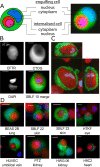Non-professional phagocytosis: a general feature of normal tissue cells
- PMID: 31417141
- PMCID: PMC6695441
- DOI: 10.1038/s41598-019-48370-3
Non-professional phagocytosis: a general feature of normal tissue cells
Erratum in
-
Author Correction: Non-professional phagocytosis: a general feature of normal tissue cells.Sci Rep. 2020 Jun 4;10(1):9345. doi: 10.1038/s41598-020-65963-5. Sci Rep. 2020. PMID: 32493921 Free PMC article.
Abstract
Non-professional phagocytosis by cancer cells has been described for decades. Recently, non-professional phagocytosis by normal tissue cells has been reported, which prompted us to take a closer look at this phenomenon. Non-professional phagocytosis was studied by staining cultured cells with live-cell staining dyes or by staining paraffin-embedded tissues by immunohistochemistry. Here, we report that each of 21 normal tissue cell lines from seven different organs was capable of phagocytosis, including ex vivo cell cultures examined before the 3rd passage as well as the primary and virus-transformed cell lines. We extended our analysis to an in vivo setting, and we found the occurrence of non-professional phagocytosis in healthy skin biopsies immediately after resection. Using dystrophin immunohistochemistry for membrane staining, human post-infarction myocardial tissue was assessed. We found prominent signs of non-professional phagocytosis at the transition zone of healthy and infarcted myocardia. Taken together, our findings suggest that non-professional phagocytosis is a general feature of normal tissue cells.
Conflict of interest statement
The authors declare no competing interests.
Figures




References
LinkOut - more resources
Full Text Sources
Molecular Biology Databases

